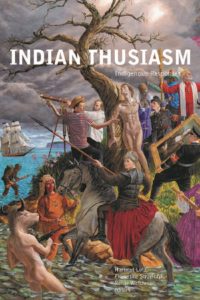Book Review: Indianthusiasm: Indigenous Responses
 Reviewed by Carrie MacKenzie
Reviewed by Carrie MacKenzie
Indianthusiasm: Indigenous Responses, is an intriguing book that examines Germany’s fascination with the Indigenous cultures of North America, also referred to as ‘Indianthusiasm’, through the eyes of Indigenous people, the majority of whom have been to Germany.
This academic work was written by Dr. Hartmut Lutz, Dr. Florentine Strzelczyk and Dr. Renae Watchman. Drs. Lutz and Strzelczyk were born in Germany and Dr. Watchman is Navajo, born in New Mexico. These academics also conducted the interviews.
There are a number of facets adding to and building on the academic importance and impact of this work. One is the introduction, where the authors discuss their research methods and why they chose the interview approach. They go on to explain the editing of the interviews. Then there are the footnotes and bibliography; both of which can help the reader deepen their understanding of the topic and give information about works on related topics.
Indianthusiasm: Indigenous Responses also offers a multilayered perspective into how Indigenous peoples feel about Germany’s interest in North American Indigenous cultures, in particular those of the Plains. All opinions were included, regardless of the speaker’s feelings about Indianthusiasm and Hobbyism, the practice of pursuing a hobby. They are asked about their thoughts on the Indigenous theme parks and the camps and clubs that practice aspects of Indigenous culture such as beading, hold pow wows, and embrace the lifestyle of Indigenous peoples found throughout Germany. Even when the interviewee did not agree with it, this was expressed respectfully. There is also the diversity of the Indigenous people who the authors interview. They interview men and women with different backgrounds and reasons for going to Germany. Therefore, it cannot be said that their experiences are the result of being a man or a woman or the circumstances that brought them to Germany. Moreover, the interviewees were exposed to a variety of people and places in Germany. This increased the validity of their experiences.
This book also illustrates what happens when people are willing to teach and learn from each other. In Germany, the interviewees realize, with surprise, that there are Caucasian people who like, value and respect them, something that they felt they had not experienced in Canada. However, this did not mean that they did not experience racism in Germany. One interviewee discusses how they were treated when they were mistaken for being Turkish and how this changed when they revealed that they were Indigenous from North America. It was also noted there were rare occasions where the German “experts” tried to tell the Indigenous people how to do certain things like drumming, highlighting another type of racism.
The tone of Indianthusiasm: Indigenous Responses is friendly and light-hearted, despite being a robust academic work. The interviewers and their subjects are talking naturally and while the interviewers ask specific questions, they also ask questions based on the responses they get. Also, from time to time, they joke with one another. The result is that the reader remains engaged and exposed to different points of view. The tone of Indianthusiasm: Indigenous Responses increases its accessibility to a variety of readers.
The language used throughout adds to the openness of Indianthusiasm: Indigenous Responses. The language allows it to reach a large and varied audience. This also keeps the reader interested and reading, promoting further dialogue and increasing awareness of this topic and the questions it raises.
This book is an amazingly insightful and thought-provoking work. Indianthusiasm: Indigenous Responses should be part of the syllabus of any Indigenous studies course or indeed any course on North American or German culture.
Hartmut Lutz, Florentine Strzelczyk, Renae Watchman, Indianthusiasm: Indigenous Responses. Ontario: Wilfrid Laurier University Press, 2020. ISBN 978-1-77112-399-0


